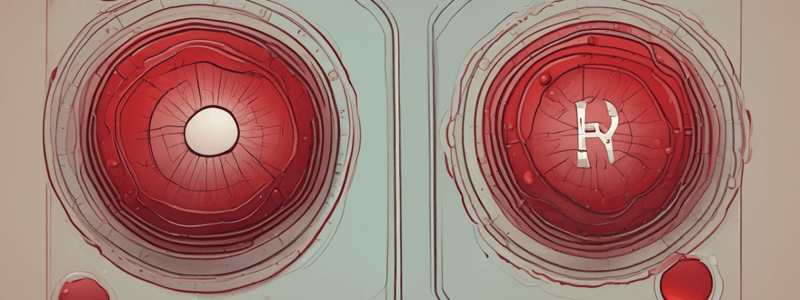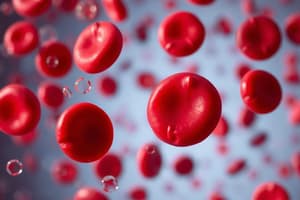Podcast
Questions and Answers
What is the primary function of the ABO antigen system?
What is the primary function of the ABO antigen system?
- To determine the compatibility of RBCs for transfusion (correct)
- To identify the Rh blood group system
- To facilitate blood clotting
- To differentiate between RBCs and WBCs
What is the recommended storage temperature for whole blood?
What is the recommended storage temperature for whole blood?
- 37°C
- 20-24°C
- -18°C
- 2-6°C (correct)
Which of the following is a viral infection that can be transmitted through blood transfusion?
Which of the following is a viral infection that can be transmitted through blood transfusion?
- Chagas disease
- HIV (correct)
- Malaria
- Creutzfeldt-Jakob disease
What is the purpose of the coagulation cascade?
What is the purpose of the coagulation cascade?
Which laboratory test is used to assess the morphology of RBCs, WBCs, and platelets?
Which laboratory test is used to assess the morphology of RBCs, WBCs, and platelets?
What is the primary function of plasma?
What is the primary function of plasma?
What is the recommended storage period for platelets?
What is the recommended storage period for platelets?
What is the cause of a delayed hemolytic reaction?
What is the cause of a delayed hemolytic reaction?
Which of the following is NOT a blood group system?
Which of the following is NOT a blood group system?
What is the recommended temperature for storing frozen plasma?
What is the recommended temperature for storing frozen plasma?
Flashcards are hidden until you start studying
Study Notes
Blood Components
- Whole blood: collected from donors, contains RBCs, WBCs, platelets, and plasma
- Red Blood Cells (RBCs):
- Function: carry oxygen to tissues
- Antigens: ABO, Rh, Kell, Duffy, Kidd, MNS
- Storage: 35-42 days at 2-6°C
- Plasma:
- Function: transport proteins, nutrients, hormones, and waste
- Frozen Plasma: stored at -18°C, thawed before use
- Platelets:
- Function: blood clotting
- Storage: 5-7 days at room temperature (20-24°C)
- White Blood Cells (WBCs):
- Function: immune response
- Removed from blood components due to risk of graft-versus-host disease
Blood Group Systems
- ABO System:
- A and B antigens on RBC surface
- A and B antibodies in plasma
- Compatibility: ABO identical or compatible
- Rh System:
- D antigen on RBC surface
- Anti-D antibodies in plasma
- Compatibility: Rh identical or compatible
- Other Blood Group Systems:
- Kell, Duffy, Kidd, MNS, and others
Blood Transfusion Reactions
- Acute Hemolytic Reaction:
- Cause: ABO incompatibility
- Symptoms: fever, chills, hemolysis
- Delayed Hemolytic Reaction:
- Cause: antibodies against RBC antigens
- Symptoms: anemia, jaundice, dark urine
- Allergic Reaction:
- Cause: hypersensitivity to blood components
- Symptoms: hives, itching, flushing
- Transfusion-Related Acute Lung Injury (TRALI):
- Cause: antibodies against WBCs or HLA
- Symptoms: respiratory distress, hypoxia
Transfusion-Transmitted Infections (TTIs)
- Viral Infections:
- HIV, HBV, HCV, HTLV
- Bacterial Infections:
- Bacterial contamination of blood components
- Parasitic Infections:
- Malaria, Chagas disease
- Prion Diseases:
- Creutzfeldt-Jakob disease, variant Creutzfeldt-Jakob disease
Haemostasis and Coagulation
- Coagulation Cascade:
- Intrinsic pathway: contact activation
- Extrinsic pathway: tissue factor activation
- Common pathway: thrombin formation
- Coagulation Factors:
- Vitamin K-dependent factors (II, VII, IX, X)
- Vitamin K-independent factors (V, VIII, XI, XII)
- Fibrinolysis:
- Plasminogen activation
- Fibrin degradation
Laboratory Testing in Haematology
- Full Blood Count (FBC):
- RBC count, Hb, Hct, MCV, MCH, MCHC
- WBC count, differential count
- Platelet count
- Blood Film Examination:
- Morphology of RBCs, WBCs, and platelets
- Coagulation Studies:
- Prothrombin Time (PT), Partial Thromboplastin Time (PTT)
- International Normalized Ratio (INR)
- Immunohaematology:
- Blood group typing, antibody screening, cross-matching
Blood Components
- Whole blood comprises red blood cells (RBCs), white blood cells (WBCs), platelets, and plasma sourced from donors.
- Red Blood Cells (RBCs) are responsible for oxygen transport to tissues and contain various antigens (ABO, Rh, Kell, Duffy, Kidd, MNS); they can be stored for 35-42 days at temperatures between 2-6°C.
- Plasma functions to transport proteins, nutrients, hormones, and waste products; frozen plasma is stored at -18°C and must be thawed before usage.
- Platelets play a crucial role in blood clotting and are viable for 5-7 days when stored at room temperature (20-24°C).
- White Blood Cells (WBCs) are essential for immune responses, but are often removed from blood components to prevent graft-versus-host disease.
Blood Group Systems
- The ABO system features A and B antigens on the surface of RBCs, with corresponding A and B antibodies found in plasma; compatibility requires identical or compatible ABO types.
- The Rh system is determined by the presence of the D antigen on RBCs and associated anti-D antibodies in plasma; compatibility is also based on identical or compatible Rh types.
- Additional blood group systems include Kell, Duffy, Kidd, and MNS, along with others.
Blood Transfusion Reactions
- Acute Hemolytic Reaction arises from ABO incompatibility, manifesting symptoms such as fever, chills, and hemolysis.
- Delayed Hemolytic Reaction is caused by antibodies against RBC antigens, with symptoms including anemia, jaundice, and dark urine.
- Allergic Reactions to blood transfusions are due to hypersensitivity to components, presenting hives, itching, and flushing.
- Transfusion-Related Acute Lung Injury (TRALI) results from antibodies against WBCs or HLA, leading to respiratory distress and hypoxia.
Transfusion-Transmitted Infections (TTIs)
- Viral infections that may be transmitted through transfusions include HIV, HBV, HCV, and HTLV.
- Bacterial infections can occur through contamination of blood components.
- Parasitic infections such as malaria and Chagas disease are also risks associated with transfusions.
- Prion diseases, including Creutzfeldt-Jakob disease and variant Creutzfeldt-Jakob disease, can be transmitted via blood.
Haemostasis and Coagulation
- The Coagulation Cascade is divided into three pathways: intrinsic (contact activation), extrinsic (tissue factor activation), and common (thrombin formation).
- Coagulation factors are categorized into vitamin K-dependent (II, VII, IX, X) and vitamin K-independent (V, VIII, XI, XII) types.
- Fibrinolysis involves the activation of plasminogen, leading to the degradation of fibrin.
Laboratory Testing in Haematology
- A Full Blood Count (FBC) evaluates RBC count, hemoglobin (Hb), hematocrit (Hct), mean corpuscular volume (MCV), mean corpuscular hemoglobin (MCH), mean corpuscular hemoglobin concentration (MCHC), WBC count, differential count, and platelet count.
- Blood Film Examination assesses the morphology of RBCs, WBCs, and platelets.
- Coagulation Studies measure Prothrombin Time (PT), Partial Thromboplastin Time (PTT), and International Normalized Ratio (INR).
- Immunohaematology involves blood group typing, antibody screening, and cross-matching for transfusion compatibility.
Studying That Suits You
Use AI to generate personalized quizzes and flashcards to suit your learning preferences.




